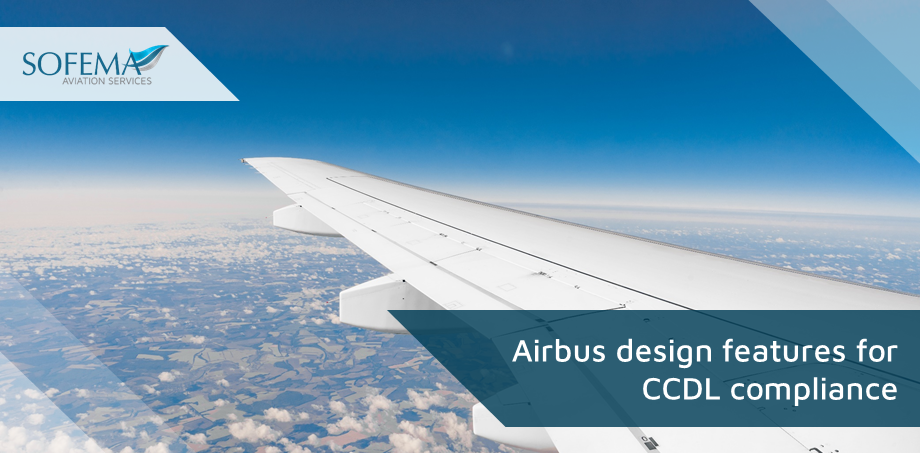Sofema (SAS) www.sassofia.com considers key features related to Airbus Fuel Tank Safety Critical Design Configuration Control Limitations (CDCCL) Design Features.
Introduction
- By design, the Airbus aircraft fuel systems have several features intended to protect them from inadvertent ignition.
Wing / Trim Tank Structure:
- The material and the many fasteners used to attach the metallic structure ensure that the fuel tank structures are electrically bonded in all the fuel tanks.
- Composite ribs are bonded using metallic strips attached to the non-metallic structure.
- All aluminium structural items in the wing, trim, and centre boxes have been finished to protect against short-circuiting of electrical harnesses within the structure.
The combination of the construction and thickness of the tank boundary skins protects against a lightning strike that causes ignition (heat).
Fuel Quantity Indicating (FQI) Equipment:
- Probes and sensors installed in tanks have low power supply.
- Electrical connection is done through a terminal block.
- The protective gap between the probes and the tank structure is maintained.
- They are electrically isolated from the structure.
Fuel pump:
- Fuel pumps have safety features to prevent pumps from working in an empty fuel tank.
- The pumps are tested to show that even after a long working condition in an “empty fuel tank”, the rotating surfaces remain lubricated and thus limit the risk of mechanical ignition.
- Each of the pumps is contained within an explosion-proof canister.
– It comprises a pump element electrically bonded to the canister and driven by an electric motor.
- Electrical connections to all pumps are made outside the tank.
– The moving parts inside the pump are usually submerged in fuel, so they cannot generate a spark during faulty conditions.
Lightning Protection:
- All equipment installed within any fuel tank is bonded to the structure
Fuel System Wiring:
- Only when necessary, wiring is routed inside fuel tanks.
- This wiring is limited to sensing and monitoring systems with very low energy-carrying requirements to protect against an ignition source resulting from high energy entering the fuel tank via the wiring.
- External electrical wiring support clamps ensure a cut cable cannot contact the fuel tank boundary or structure in a fuel vapour area.
- There is a complete segregation between in-tank wiring equipment and fuel calculators from other aircraft system wirings.
Valves:
- All motor-operated valves within the fuel tanks have actuators outside the tank wall.
- The valve mechanisms inside the tank are dual-bonded and do not have an ignition hazard.
Pressure Switches:
- Pump pressure switches are mounted on the tank boundaries.
– They are separated from the fuel by a diaphragm. The electrical connections are fully sealed and explosion-proof.
Fuel Leaks:
- Fuel or fuel vapour can leak from a fuel tank into an adjacent area, and the accumulated fuel can become hazardous, causing ignition.
– Fuel leaks from the wing and trim tanks go either to the leading or trailing edge cavities or to the outside.
– Any fuel overflowing from the NACA intake is directed downwards and away from the engines (heat source) via a fuel leak drip strip (angle section) located onboard of the NACA intake.
– The equipment is explosion-proofed and insulated from leakage in the leading and trailing edges.
– The APU fuel feed and Trim Tank transfer pipes at the rear fuselage are shrouded so any fuel leakage is drained overboard via the drain mast.
Heat Sources:
- Wing leading edges contain hot air ducting from the engines to the bleed air and anti-icing systems.
– These pipes are insulated and separated from the tank boundary.
Next Steps
Follow this link to our Library to find & download related documents for Free.
Sofema Aviation Services www.sassofia.com and Sofema Online www.sofemaonline.com provide Fuel Tank Safety & Fuel Tank Entry classroom webinar and online training. Please see the websites or email team@sassofia.com for comments or questions.
Tags:
Fuel Tank Safety, SAS blogs, CDCCL - Critical Design Configuration Control Limitations, Critical Design Configuration Control Limitations, Fuel Quantity Indicating, Valves, Pressure Switches, Heat Sources, Wing Structure, Tank Structure





